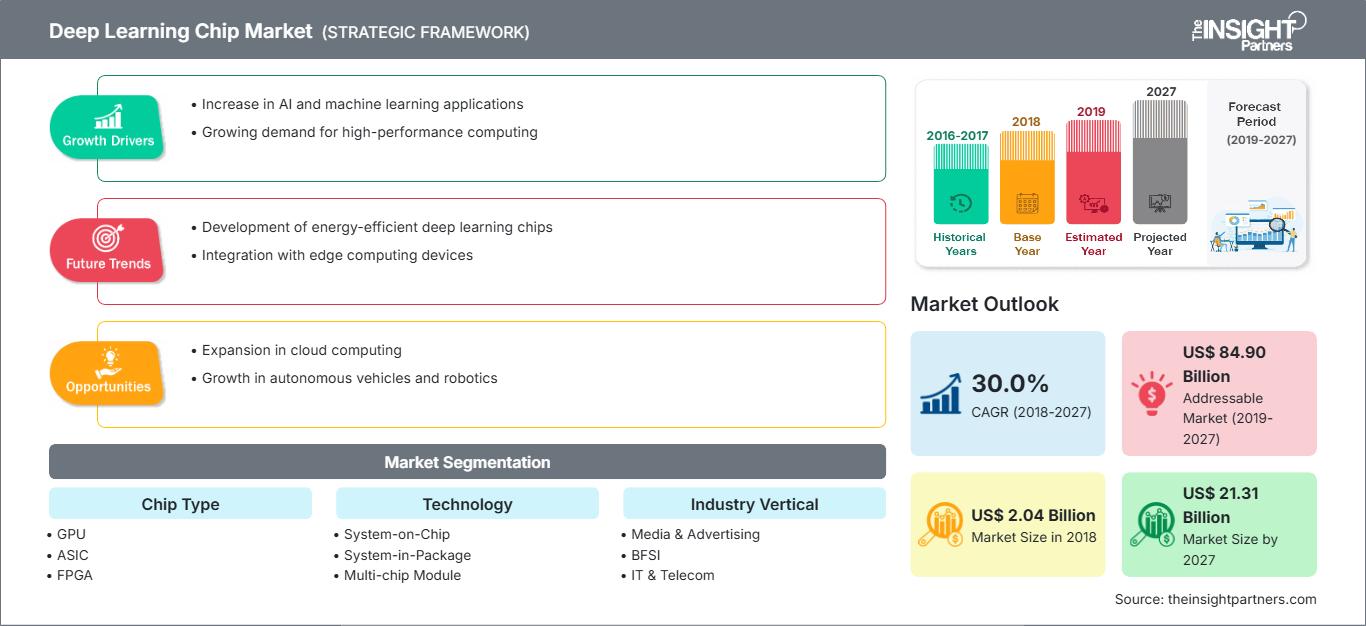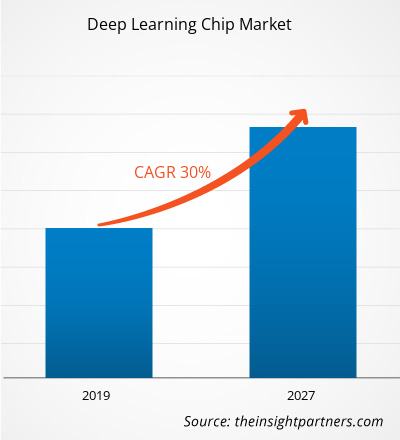2018 年全球深度学习芯片市场规模为 20.4 亿美元,预计在 2019 年至 2027 年预测期内,复合年增长率将达到 30.0%,到 2027 年将达到 213.1 亿美元。
北美引领全球深度学习芯片市场,预计在整个预测期内将成为最大的收入贡献者。深度学习芯片的开发得到了科技巨头大规模投资的支持,旨在从大量生成的数据中开发模式。量子计算的兴起和深度学习芯片在机器人技术中的应用正在推动北美国家深度学习芯片市场的增长。
市场洞察:量子计算的突出地位促进了深度学习芯片市场的增长
量子计算只需几秒钟即可完成原本需要更多时间的计算。量子计算机是人工智能、机器学习和大数据的创新变革。因此,量子计算的崛起预计将推动深度学习芯片市场的增长。此外,量子计算在投资组合优化、欺诈检测、风险管理以及需要即时数据反馈的领域等诸多领域都大有裨益。因此,单个处理器更容易在几秒钟内完成复杂的计算。此外,凭借互联网的规模和规模,深度学习有助于以极低的成本维护大型数据集。因此,这些因素预计将推动全球深度学习芯片市场的增长。
自定义此报告以满足您的要求
您将免费获得任何报告的定制,包括本报告的部分内容,或国家级分析、Excel 数据包,以及为初创企业和大学提供超值优惠和折扣
深度学习芯片市场: 战略洞察

-
获取本报告的主要市场趋势。这个免费样本将包括数据分析,从市场趋势到估计和预测。
商业竞争日趋激烈,为了有效竞争,如今的企业依赖于实用信息和业务分析。传统上,企业使用业务分析工具根据一周或一个月前的事件数据来预测销售额。随着能够实时学习并根据模式提供建议的人工智能技术的出现,企业拥有巨大的机会将深度学习应用于各种流程,以更好地了解业务环境和客户。
考虑到这些因素,人工智能使企业能够提高运营效率、降低运营成本、提升服务质量和客户体验。
芯片类型洞察
图形处理单元 (GPU) 在 2018 年占据了深度学习芯片市场的主要份额,而专用集成电路 (ASIC) 预计将成为预测期内增长最快的细分市场。虽然 ASIC 非常专用且灵活性较差,但它们是人工智能应用中性能最高的硬件选项之一。
技术洞察
深度学习芯片组包括片上系统、系统级封装、多芯片模块等,以及其他芯片组。片上系统部分在 2018 年占据了深度学习芯片的主要份额,因为它有助于减少能源浪费、大型系统占用的空间和成本。
行业垂直洞察
全球深度学习芯片市场分为 BFSI、零售、IT 和电信、汽车和交通、医疗保健、媒体和娱乐以及其他。BFSI 在深度学习芯片市场中占据主要市场份额,而医疗保健预计将成为市场中增长最快的部分。降低运营成本、适应不断变化的合规性和法规、专注于核心业务以及将自动化集成到业务流程等因素是推动深度学习芯片市场 BFSI 部门增长的其他主要因素。
深度学习芯片市场的市场参与者主要专注于通过实施先进技术来增强产品性能。通过签署合作伙伴关系、合同、合资企业、融资和在世界各地开设新办事处,该公司可以在全球范围内维护其品牌名称。以下列出了一些最近的发展;
2019 年:NVIDIA 与 Hackster.io 合作推出 AI at the Edge Challenge,这是一项竞赛,开发人员利用 NVIDIA Jetson Nano 开发套件构建富有创意和独特的项目,并有机会赢取 10 万美元的奖金。
2019 年:英特尔宣布计划扩建俄勒冈工厂以生产 7nm 芯片。英特尔的新工厂将是英特尔于2010年启动的大型工厂D1X的第三期。前两期各占地110万平方英尺,总面积相当于15家Costco仓储式商店。第三期预计将使D1X的生产空间增加约50%。此外,英特尔表示,工厂扩建将使其对芯片短缺的响应速度提高60%。
2019年:华为推出业界首款T级AIFW(人工智能防御防火墙)。HiSecEngine USG12000搭载昇腾AI芯片,为企业网络提供智能检测能力和智能边界防御。
深度学习芯片市场区域洞察
The Insight Partners 的分析师已详尽阐述了预测期内影响深度学习芯片市场的区域趋势和因素。本节还讨论了北美、欧洲、亚太地区、中东和非洲以及南美和中美洲的深度学习芯片市场细分和地域分布。
深度学习芯片市场报告范围
| 报告属性 | 细节 |
|---|---|
| 市场规模 2018 | US$ 2.04 Billion |
| 市场规模 2027 | US$ 21.31 Billion |
| 全球复合年增长率 (2018 - 2027) | 30.0% |
| 历史数据 | 2016-2017 |
| 预测期 | 2019-2027 |
| 涵盖的领域 |
By 芯片类型
|
| 覆盖地区和国家 |
北美
|
| 市场领导者和主要公司简介 |
|
深度学习芯片市场参与者密度:了解其对商业动态的影响
深度学习芯片市场正在快速增长,这得益于终端用户需求的不断增长,而这些需求的驱动因素包括消费者偏好的演变、技术进步以及对产品优势的认知度的提升。随着需求的增长,企业正在扩展产品线,不断创新以满足消费者需求,并抓住新兴趋势,从而进一步推动市场增长。

- 获取 深度学习芯片市场 主要参与者概述
- GPU
- ASIC
- FPGA
- CPU
- 其他
按技术
- 片上系统
- 系统级封装
- 多芯片模块
- 其他
按垂直行业
- 媒体与广告
- BFSI、IT 与电信
- 零售
- 医疗保健
- 汽车与交通运输
- 其他
按地理位置
-
北美
- 美国
- 加拿大
- 墨西哥
-
欧洲
- 法国
- 德国
- 英国
- 俄罗斯
- 意大利
- 欧洲其他地区
-
亚太地区 (APAC)
- 澳大利亚
- 中国
- 印度
- 日本
- 韩国
- 亚太地区其他地区
-
中东和非洲 (MEA)
- 沙特阿拉伯
- 南非
- 阿联酋
- MEA 其他地区
-
南美洲 (SAM)
- 巴西
- 阿根廷
- SAM 其他地区
公司简介
- Advanced Micro Devices, Inc.
- Alphabet Inc. (Google)
- Amazon.com, Inc.
- 百度公司
- 华为技术有限公司
- 英特尔公司
- NVIDIA Corporation
- Qualcomm Incorporated
- 三星电子有限公司
- Xilinx, Inc.
- 历史分析(2 年)、基准年、预测(7 年)及复合年增长率
- PEST和SWOT分析
- 市场规模、价值/数量 - 全球、区域、国家
- 行业和竞争格局
- Excel 数据集
近期报告
客户评价
购买理由
- 明智的决策
- 了解市场动态
- 竞争分析
- 客户洞察
- 市场预测
- 风险规避
- 战略规划
- 投资论证
- 识别新兴市场
- 优化营销策略
- 提升运营效率
- 顺应监管趋势






















 获取免费样品 - 深度学习芯片市场
获取免费样品 - 深度学习芯片市场